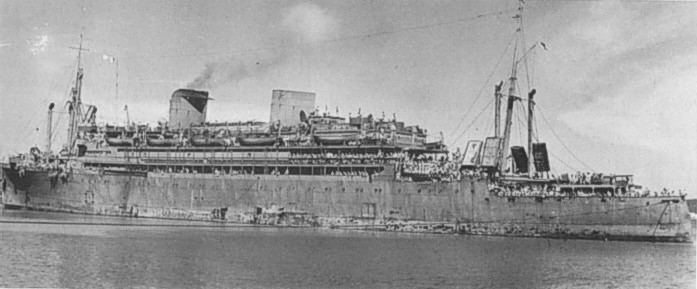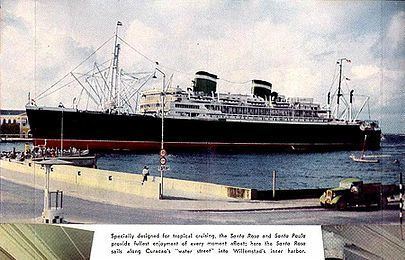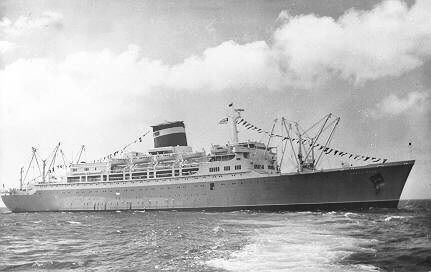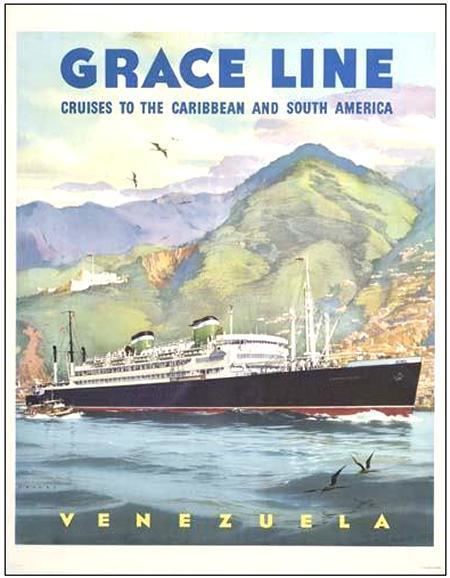Name SS Santa Rosa Ordered 1930 Length 155 m | Port of registry New York Maiden voyage 26 November 1932 | |
 | ||
Route New York - Havana - Cristobal - the Panama Canal - Balboa - Puntarenas - La Libertad - San Jose de Guatemala - Mazatlan - Los Angeles - San Francisco - Victoria - Seattle. | ||
SS Santa Rosa (later SS Athinai) was a passenger and cargo ocean liner built for the Grace Line. She was one of four sister ships (the others being Santa Elena, Santa Lucia and Santa Paula) ordered in 1930 from the Federal Shipbuilding and Drydock Company of Kearny, NJ. Her regular route included inter-coastal service between the east coast and the west coast of the USA via the Caribbean and the Panama Canal. She was the second of ultimately three vessels to bear the name Santa Rosa for the Grace Line. (The first Santa Rosa was a 1917-built ship that was sold in 1925.)
Contents
- Design and construction
- Prewar Grace Line service
- World War II service
- Postwar Grace Line service
- Typaldos Lines service
- 196689
- References

Design and construction

Designed by Gibbs & Cox, Santa Rosa bore some resemblance to their later ships, the SS America and SS United States. such as his signature winged funnel. The public rooms were all on the promenade deck. The dining room was located on this deck between the two funnels and had an atrium stretching up two and a half decks. Unique for its day was a retractable roof which allowed the passenger to dine under the tropical sky. The Grace Line also employed female waitresses instead of male stewards. All first class cabins were outside twin beds and private baths.[dead link]
Prewar Grace Line service

The Santa Rosa sailed on her maiden voyage on 26 November 1932. Her East-West coast route of New York-Seattle was 20 days and included a one-day call in Los Angeles and two days in San Francisco. The ship's service speed of 20 knots and her superior accommodation made her very popular compared to that offered by Pacific Coast shipping. In 1936 however the intercoastal service ended and Santa Rosa and her sisters transferred to service to the Caribbean.
World War II service

Santa Rosa was requisitioned by the US War Shipping Administration on 3 January 1942 with Grace Line operating the ship as agents and allocated to Army for troop service. Even in wartime gray, the ship retained her elegant oceanliner lines:

Santa Rosa made 21 voyages from the east coast of the US from 1942-1945: one to Europe, one to Australia, one to India, and three to Africa.
Her wartime voyages included:
The vessel was returned to Grace Line on 3 February 1947.
Postwar Grace Line service
After her war service she underwent repair and refit at the Newport News Shipbuilding & Drydock Company prior to redelivery to her owners. Santa Rosa returned to Grace Line and resumed the Caribbean service on 7 February 1947. In 1958, after 26 years of service, Santa Rosa was replaced by a larger liner of the same name. In June 1958 Santa Rosa was renamed Santa Paula. The older ship was laid up at Hoboken, NJ until 1961 when she was sold to Greek owners.
Typaldos Lines service
Santa Rosa was renamed Athinai and began a new career as a cruise ship for Typaldos Lines. A refit increased her accommodation and converted her to carry three classes of passengers. She entered service for her new owners for voyages in the Mediterranean, Black Sea and Adriatic. Athinai in her Typaldos Line livery appears briefly in a scene of the port of Piraeus, Greece, in the 1963 film The Bullfighter Advances. In 1968 the Typaldos Lines owners were arrested and the company disbanded after the Greek government investigation of the SS Heraklion incident found them guilty of manslaughter and negligence. The company's ships were taken over and sold except for two, including SS Athinai, who attracted no buyers and were subsequently laid up at Phaleron Bay.
1966–89
Santa Rosa/Athinai never returned to active service. In 1978 she was towed out of layup for use as a film set for Raise the Titanic. After a decade of neglect, and with fittings that did not appear to be out of place on a 1912 built ship, Athinai needed very little conversion work for filming the Titanic’s interiors. Her bows were painted to resemble Titanic and she was sprayed with concrete to simulate 68 years on the ocean floor. After the filming she was returned to Phaleron Bay. She remained for another ten years until 1989, when she was towed for scrapping at Aliağa, Turkey in a purge of derelict shipping.
